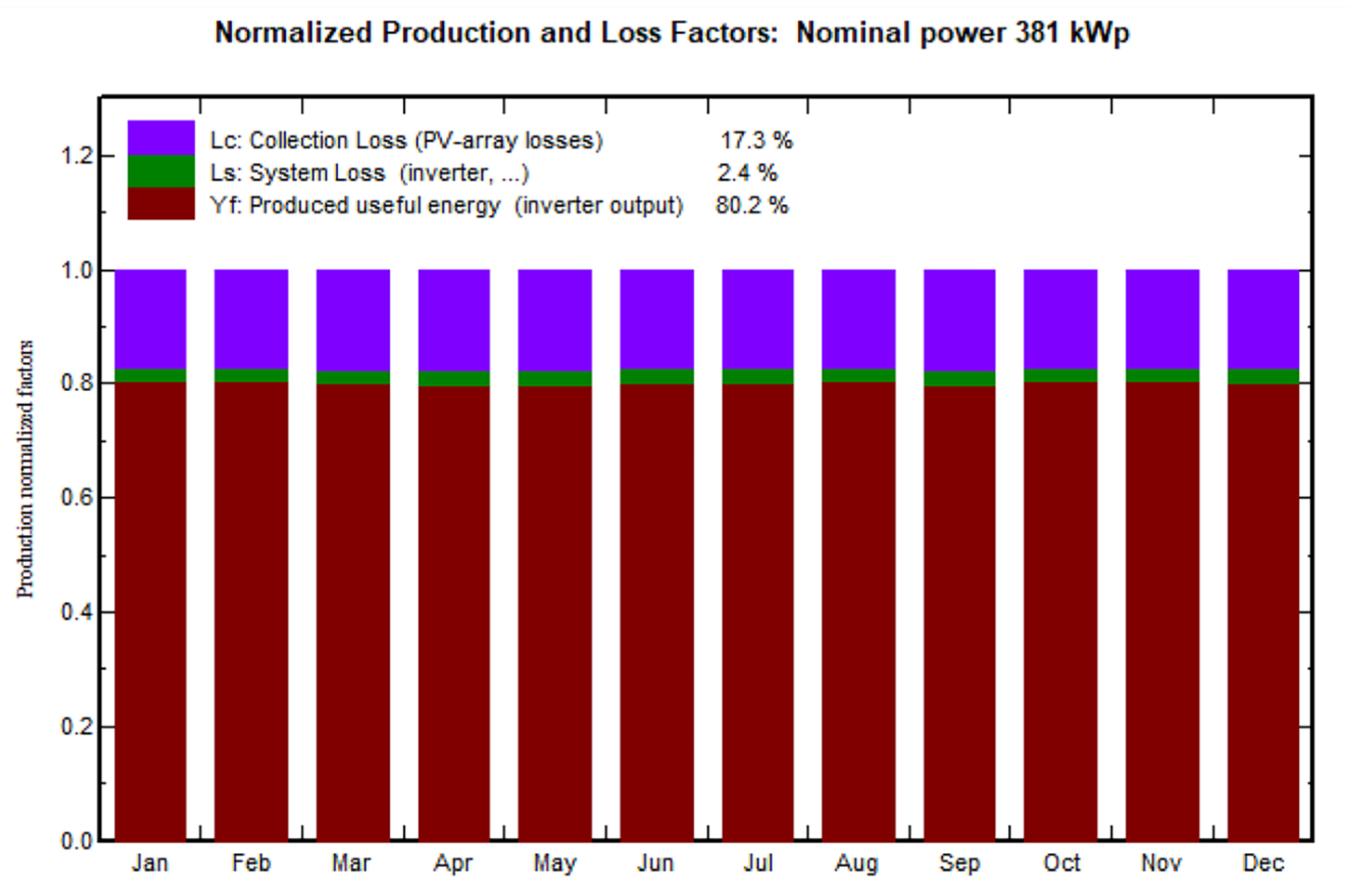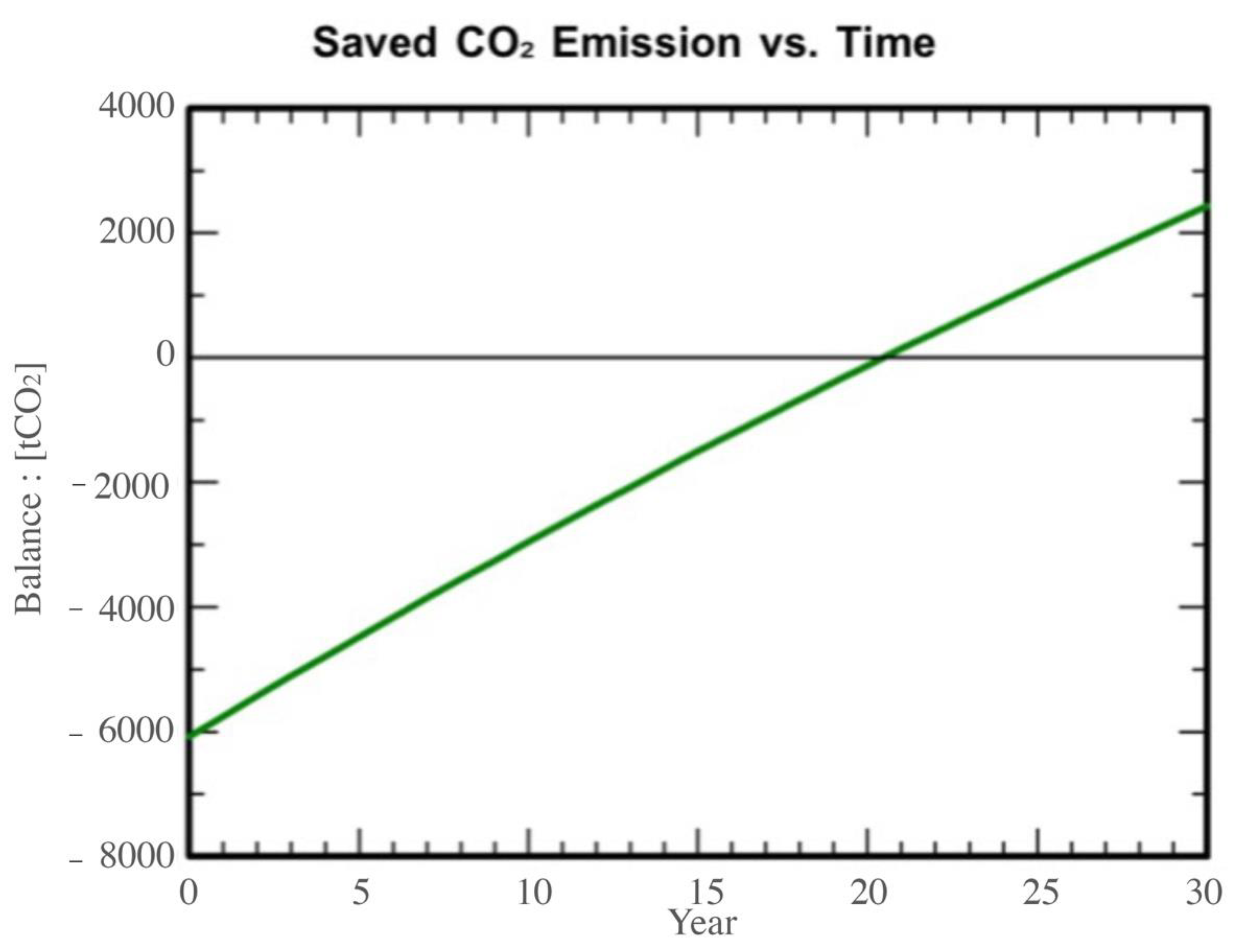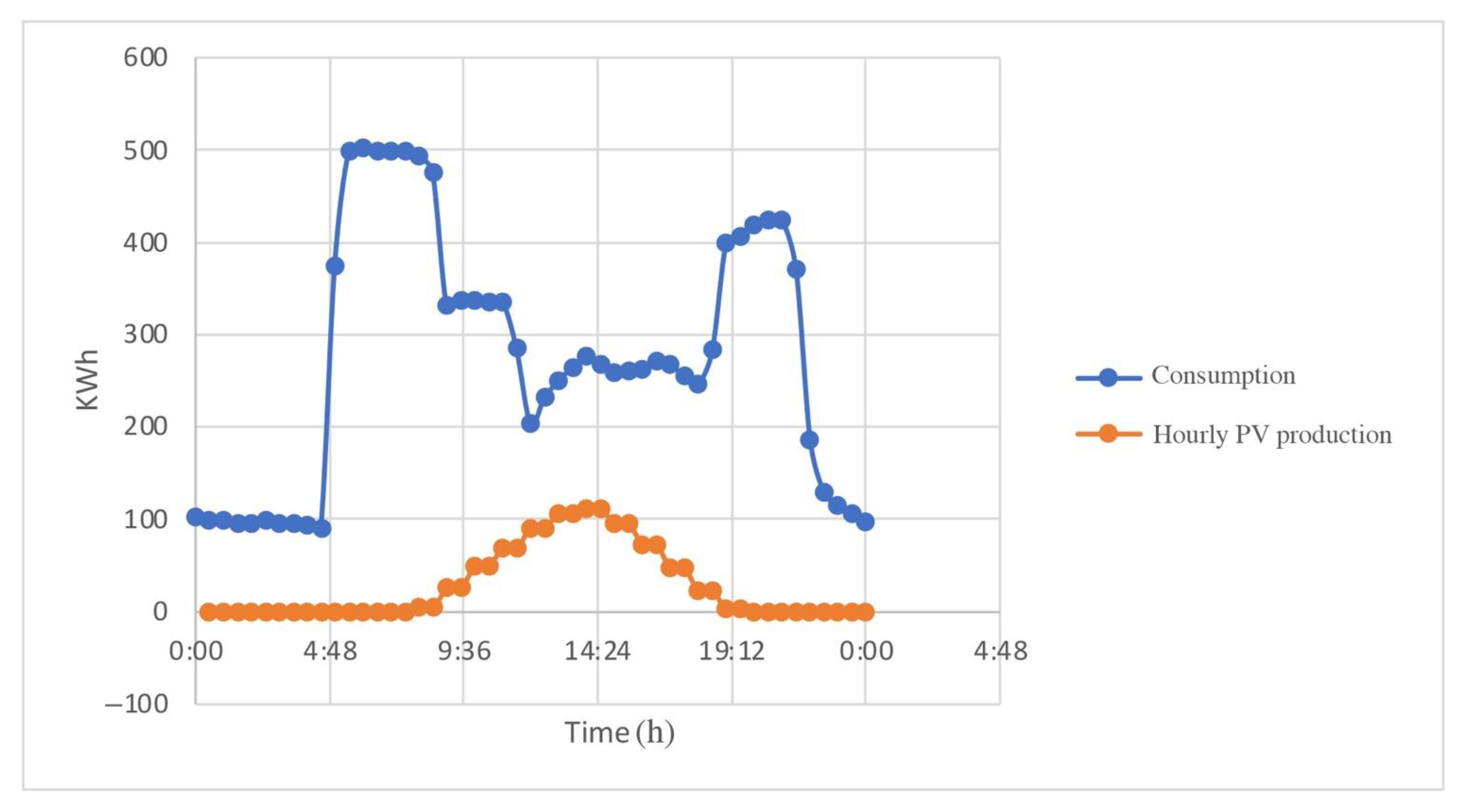Techno-Economic Analysis of Commercial Size Grid-Connected Rooftop Solar PV Systems in Malaysia under the NEM 3.0 Scheme
Abstract
:1. Introduction
1.1. Motivation
1.2. Brief on Solar PV Policies in Malaysia
1.3. Grid-Connected PV System
1.4. Contribution and Paper Organization
2. Methodology
3. System Configuration
4. Load Profile
5. System Sizing
6. PV System Analysis Using PVsyst Tools
7. Financial Analysis
8. Environmental Impact
9. Discussion
10. Conclusions
Author Contributions
Funding
Institutional Review Board Statement
Informed Consent Statement
Data Availability Statement
Conflicts of Interest
References
- Tsoutsos, T.; Frantzeskaki, N.; Gekas, V. Environmental impacts from the solar energy technologies. Energy Policy 2005, 33, 289–296. [Google Scholar] [CrossRef]
- Vaka, M.; Walvekar, R.; Rasheed, A.K.; Khalid, M. A review on Malaysia’s solar energy pathway towards carbon-neutral Malaysia beyond COVID’19 pandemic. J. Clean. Prod. 2020, 273, 122834. [Google Scholar] [CrossRef]
- SEDA. Sustainable Energy Development Authority Malaysia. “Grid Parity; Displaced Cost”. Available online: http://www3.seda.gov.my (accessed on 10 October 2021).
- Gomesh, N.; Daut, I.; Irwanto, M.; Irwan, Y.; Fitra, M. Study on Malaysian’s Perspective towards Renewable Energy Mainly on Solar Energy. Energy Procedia 2013, 36, 303–312. [Google Scholar] [CrossRef] [Green Version]
- Fayaza, H.; Rahimb, N.A.; Saidura, R.; Solangi, K.H.; Niaz, H.; Hossaina, M.S. Solar Energy Policy: Malaysia vs. De-veloped Countries. In Proceedings of the IEEE Conference on Clean Energy and Technology (CET), Kuala Lumpur, Malaysia, 27–29 June 2011; pp. 374–378. [Google Scholar]
- Zhang, H.L.; Van Gerven, T.; Baeyens, J.; Degrève, J. Photovoltaics: Reviewing the European Feed-in-Tariffs and Changing PV Efficiencies and Costs. Sci. World J. 2014, 2014, 1–10. [Google Scholar] [CrossRef] [PubMed]
- Chua, S.C.; Oh, T.H.; Goh, W.W. Feed-in tariff outlook in Malaysia. Renew. Sustain. Energy Rev. 2011, 15, 705–712. [Google Scholar] [CrossRef]
- Wong, S.L.; Ngadi, N.; Abdullah, T.A.T.; Inuwa, I. Recent advances of feed-in tariff in Malaysia. Renew. Sustain. Energy Rev. 2015, 41, 42–52. [Google Scholar] [CrossRef]
- Solangi, K.H.; Saidur, R.; Rahim, N.A.; Islam, M.R.; Fayaz, H. Current solar energy policy and potential in Malay-sia, 3rd. In Proceedings of the International Conference on Science and Technology, Pulau Pinang, Malaysia, 12–13 December 2008. [Google Scholar]
- Saadatian, O.; Haw, L.C.; Mat, S.B.; Sopian, K. Perspective of sustainable development in Malaysia. Int. J. Energy Environ. 2012, 6, 260–267. [Google Scholar]
- New Economic Model for Malaysia Part 1. Available online: https://www.pmo.gov.my/dokumenattached/NEM_Report_I.pdf (accessed on 10 October 2021).
- Raza, M.; Alshebami, A.S.; Sibghatullah, A. Factors Influencing Renewable Energy Technological Innovation in Malaysia. Int. J. Energy Econ. Policy 2020, 10, 573–579. [Google Scholar] [CrossRef]
- Islam, S.Z.; Othman, M.L.; Saufi, M.; Omar, R.; Toudeshki, A. Photovoltaic modules evaluation and dry-season energy yield prediction model for NEM in Malaysia. PLoS ONE. 2020, 15, e0241927. [Google Scholar] [CrossRef] [PubMed]
- Husain, A.A.; Phesal, M.H.A.; Kadir, M.Z.A.; Amirulddin, U.A.U. Short Review on recent solar PV policies in Malaysia. E3s Web Conf. 2020, 191, 1002. [Google Scholar] [CrossRef]
- Poullikkas, A.; Kourtis, G.; Hadjipaschalis, I. A review of net metering mechanism for electricity renewable energy sources. Int. J. Energy Environ. 2013, 4, 975–1002. [Google Scholar]
- Abdullah, W.S.W.; Osman, M.; Ab Kadir, M.Z.A.; Verayiah, R. The potential and status of renewable energy de-velopment in Malaysia. Energies 2019, 12, 2437. [Google Scholar] [CrossRef] [Green Version]
- Christoforidis, G.C.; Chrysochos, A.; Papagiannis, G.; Hatzipanayi, M.; Georghiou, G.E. Promoting PV energy through net metering optimization: The PV-NET Project. In Proceedings of the 2013 International Conference on Renewable Energy Research and Applications (ICRERA), San Diego, CA, USA, 17–22 October 2013. [Google Scholar]
- Razali, A.H.; Abdullah, P.; Hassan, M.Y.; Hussin, F. Comparison of New and Previous Net Energy Metering (NEM) Scheme in Malaysia. Elektr. J. Electr. Eng. 2019, 18, 36–42. [Google Scholar] [CrossRef]
- Dutta, S.; Ghosh, D.; Mohanta, D.K. Optimum solar panel rating for net energy metering environment. In Proceedings of the 2016 International Conference on Electrical, Electronics, and Optimization Techniques (ICEEOT), Chennai, India, 3–5 March 2016; IEEE: Piscataway, NJ, USA, 2016; pp. 2900–2904. [Google Scholar] [CrossRef]
- Abdul, R.D. Sustainable Energy, Suruhanjaya Tenaga Energy Commission. Available online: http://gtalcc.gov.my/wp-content/uploads/2021/08/Sustainable-Energy-Energy-Efficiency-Renewable-Energy.pdf (accessed on 21 October 2021).
- Zainudin, N.; Sharifuddin, N.S.I.; Osman, S.; Jusoh, Z.M.; Paim, L.; Zainalaludin, Z.; Nordin, N. Validating of So-lar Energy Acceptance Measurements Among Malaysian Households. Int. J. Soc. Sci. Res. 2020, 2, 20–31. [Google Scholar]
- Tan, R.H.; Chow, T. A Comparative Study of Feed in Tariff and Net Metering for UCSI University North Wing Campus with 100 kW Solar Photovoltaic System. Energy Procedia 2016, 100, 86–91. [Google Scholar] [CrossRef] [Green Version]
- Husain, A.A.F.; Phesal, M.H.A.; Ab Kadir, M.Z.A.; Amirulddin, U.A.U.; Junaidi, A.H.J. A Decade of Transitioning Malaysia toward a High-Solar PV Energy Penetration Nation. Sustainability 2021, 13, 9959. [Google Scholar] [CrossRef]
- Chaurey, A.; Deambi, S. Battery storage for PV power systems: An overview. Renew. Energy 1992, 2, 227–235. [Google Scholar] [CrossRef]
- Ip, A.H.; Thon, S.; Hoogland, S.; Voznyy, O.; Zhitomirsky, D.; Debnath, R.K.; Levina, L.; Rollny, L.R.; Carey, G.H.; Fischer, A.H.; et al. Hybrid passivated colloidal quantum dot solids. Nat. Nanotechnol. 2012, 7, 577–582. [Google Scholar] [CrossRef] [PubMed]
- Alwaeli, A.H.A.; Sopian, K.; Kazem, H.A.; Chaichan, M.T. Photovoltaic/Thermal (PV/T) systems: Status and future prospects. Renew. Sustain. Energy Rev. 2017, 77, 109–130. [Google Scholar] [CrossRef]
- Marańda, W.; Piotrowicz, M. Sizing of photovoltaic array for low feed-in tariffs. In Proceedings of the 21st International Conference Mixed Design of Integrated Circuits and Systems (MIXDES), Lublin, Poland, 19–21 June 2014; pp. 405–408. [Google Scholar]
- Murdan, A.P.; Jeetun, A.K. Simulation of a Single Phase Grid-tied PV System under Net-Metering Scheme. In Proceedings of the 2021 IEEE Power and Energy Conference at Illinois (PECI), Urbana, IL, USA, 1–2 April 2021; IEEE: Piscataway, NJ, USA, 2021; pp. 1–6. [Google Scholar] [CrossRef]
- Ratnam, E.L.; Weller, S.R.; Kellett, C. Scheduling residential battery storage with solar PV: Assessing the benefits of net metering. Appl. Energy 2015, 155, 881–891. [Google Scholar] [CrossRef]
- For Solar Photovoltaic Installation under the Programme of NEM Rakyat and NEM GoMEn in Peninsular Malaysia. Available online: http://www.seda.gov.my/reportal/nem/ (accessed on 10 October 2021).
- Zainuddin, H.; Salikin, H.R.; Shaari, S.; Hussin, M.Z.; Manja, A. Revisiting solar photovoltaic roadmap of tropical malaysia: Past, present and future. Pertanika J. Sci. Technol. 2021, 29, 1567–1578. [Google Scholar] [CrossRef]
- Gitizadeh, M.; Fakharzadegan, H. Battery capacity determination with respect to optimized energy dispatch schedule in grid-connected photovoltaic (PV) systems. Energy 2014, 65, 665–674. [Google Scholar] [CrossRef]
- Seepromting, K.; Chatthaworn, R.; Khunkitti, P.; Kruesubthaworn, A.; Siritaratiwat, A.; Surawanitkun, C. Distribution company investment cost reduction analysis with grid-connected solar PV allocation in power distribution system. Int. J. Smart Grid Clean Energy 2020. [Google Scholar] [CrossRef]
- Subramaniam, U.; Vavilapalli, S.; Padmanaban, S.; Blaabjerg, F.; Holm-Nielsen, J.B.; Almakhles, D. A Hybrid PV-Battery System for ON-Grid and OFF-Grid Applications—Controller-In-Loop Simulation Validation. Energies 2020, 13, 755. [Google Scholar] [CrossRef] [Green Version]
- Yusoff, N.F.; Zakaria, N.Z.; Zainuddin, H.; Shaari, S. Mounting Configuration factor for building integrated photovol-taic and retrofitted grid-connected photovoltaic system. Sci. Lett. 2017, 11, 1–6. [Google Scholar]
- Watts, D.; Valdés, M.F.; Jara, D.; Watson, A. Potential residential PV development in Chile: The effect of Net Metering and Net Billing schemes for grid-connected PV systems. Renew. Sustain. Energy Rev. 2015, 41, 1037–1051. [Google Scholar] [CrossRef]
- Humada, A.M.; Aaref, A.M.; Hamada, H.M.; Sulaiman, M.H.; Amin, N.; Mekhilef, S. Modeling and characterization of a grid-connected photovoltaic system under tropical climate conditions. Renew. Sustain. Energy Rev. 2017, 82, 2094–2105. [Google Scholar] [CrossRef]
- Mekhilef, S.; Barimani, M.; Safari, A.; Salam, Z. Malaysia’s renewable energy policies and programs with green aspects. Renew. Sustain. Energy Rev. 2014, 40, 497–504. [Google Scholar] [CrossRef]
- Mansur, T.M.N.T.; Baharudin, N.H.; Ali, R. A Comparative Study for Different Sizing of Solar PV System under Net Energy Metering Scheme at University Buildings. Bull. Electr. Eng. Inform. 2018, 7, 450–457. [Google Scholar] [CrossRef]
- Irwan, Y.; Amelia, A.; Irwanto, M.; Fareq, M.; Leow, W.; Gomesh, N.S.I. Stand-Alone Photovoltaic (SAPV) System Assessment using PVSYST Software. Energy Procedia 2015, 79, 596–603. [Google Scholar] [CrossRef] [Green Version]
- Gharakhani Siraki, A.; Pillay, P.D. Comparison of PV System Design Software Packages for Urban Applications; IEEE: Piscataway, NJ, USA, 2010. [Google Scholar]
- NASA-SSE Satellite Data. Available online: http://eosweb.larc.nasa.gov/sse/ (accessed on 10 October 2021).







| Policy | Year | Definition | Notes | Ref. |
|---|---|---|---|---|
| FiT | 2011–2016 | The concept of FiTs is that the yield of the user-generated photovoltaic system is sold to the utility grid at a price set by the utility network. Two meters are installed; one is used to count the electricity consumed by the user, and the second meter measures the kWh produced by the PV system and sent to the grid. | It was the first policy implemented in Malaysia. | [6,7,8] |
| NEM 1.0 | 2016–2019 | NEM enables customers to produce and use solar energy to satisfy demand. The extra PV electricity will be exported to the grid. This surplus power is subsequently offset by a rate of MYR 0.31/kWh from the next electricity bill. | The energy produced by the PV system is consumed by the owner and the excess energy is exported to the grid. There is not money offset—only a reduction in the next electricity bill. | [15,20,27,28] |
| NEM 2.0 | 2019–2021 | This policy allows a consumer who produces photovoltaic energy to export the excess energy to the grid, and each kWh is compensated by another kWh from the next electricity bill. | Each one kWh exported to the grid will be offset from the next electricity bill by deducting the value of one kWh starting with the highest tariff. In the previous NEM, the energy exported to the grid would only be paid at a displaced cost of MYR 0.31/kWh. | [16,21,29] |
| NEM 3.0 | 2021–2023 | Similar concept to NEM 2.0, apart from that it permits indirect connection to commercial buildings. The allowed installed capacity is 75% of MD for commercial buildings. | A hybrid system/indirect connection is allowed | [30] |
| Type | Information |
|---|---|
| Location | Bangi, Selangor (Klang Valley) |
| Slope azimuth | 180 |
| Roof type | Clay and concrete tiles |
| Month | Demand, kWh | MD, kW | MD, MYR | Cost, MYR |
|---|---|---|---|---|
| JAN | 141,265 | 95 | 4285 | 47,957 |
| FEB | 127,680 | 552 | 24,895 | 43,727 |
| MAR | 346,075 | 95 | 4285 | 129,553 |
| APRIL | 100,093 | 502 | 22,640 | 100,094 |
| MAY | 357,702 | 494 | 22,279 | 108,422 |
| JUN | 283,652 | 499 | 22,505 | 113,256 |
| JULY | 344,294 | 514 | 23,181 | 133,032 |
| AUG | 342,547 | 503 | 22,685 | 342,158 |
| SEP | 299,892 | 502 | 22,640 | 118,990 |
| OCT | 331,863 | 491 | 22,144 | 128,770 |
| NOV | 335,701 | 498 | 22,460 | 130,132 |
| DEC | 283,513 | 496 | 22,370 | 113,350 |
| TOTAL | 3,194,184 | - | - | 1,509,441 |
| Average | 274,523 | 505 * | 19,697 | 125,787 |
| Month | AC System Output (kWh) | Solar Radiation (kWh/m2/day) | Irradiance (W/m2) | DC Array Output (kWh) |
|---|---|---|---|---|
| 1 | 103.19 | 4.44 | 137.60 | 107.85 |
| 2 | 95.95 | 4.55 | 127.47 | 100.29 |
| 3 | 104.86 | 4.52 | 140.15 | 109.62 |
| 4 | 94.78 | 4.19 | 125.55 | 99.10 |
| 5 | 89.40 | 3.80 | 117.80 | 93.58 |
| 6 | 85.31 | 3.77 | 113.08 | 89.36 |
| 7 | 89.52 | 3.80 | 117.91 | 93.78 |
| 8 | 94.33 | 4.01 | 124.28 | 98.72 |
| 9 | 95.52 | 4.21 | 126.16 | 99.85 |
| 10 | 98.78 | 4.21 | 130.44 | 103.25 |
| 11 | 95.13 | 4.20 | 125.87 | 99.45 |
| 12 | 95.95 | 4.05 | 125.55 | 100.34 |
| Total | 1142.72 | 49.74 | 1511.86 | 1195.19 |
| Parameters | Values |
|---|---|
| PV module size | 470 Wp |
| Number of modules | 810 units |
| Nominal (STC) | 380 kWp |
| Modules | 81 strings × 10 in series |
| Pmpp | 707 V |
| Umpp | 501 A |
| Module area | 1751 m2 |
| Parameters | Values |
|---|---|
| Unit Nom Power | 100 kWac |
| Number of inverters | 3 units |
| Total power | 380 kWac |
| Operating voltage | 630–1000 V |
| Pnom ratio (DC:AC) | 1.27 |
| GlobHor kWh/m2 | DiffHor kWh/m2 | T_Amb °C | Globlnc kWh/m2 | GlobEff kWh/m2 | EArray MWh | E_Grid MWh | E_Grid MWh | |
|---|---|---|---|---|---|---|---|---|
| JAN | 133.6 | 79.58 | 27.21 | 140.4 | 137.0 | 44.38 | 43.10 | 0.806 |
| FEB | 131.6 | 81.85 | 27.84 | 135.4 | 132.0 | 42.72 | 41.55 | 0.806 |
| MAR | 153.8 | 88.56 | 28.27 | 153.6 | 149.9 | 48.24 | 46.89 | 0.802 |
| APR | 142.7 | 73.33 | 27.86 | 138.6 | 135.0 | 43.44 | 42.15 | 0.799 |
| MAY | 144.8 | 77.78 | 28.71 | 136.7 | 132.5 | 42.88 | 41.59 | 0.799 |
| JUN | 133.0 | 70.24 | 28.20 | 124.4 | 120.7 | 39.19 | 37.98 | 0.802 |
| JUL | 134.4 | 81.91 | 28.20 | 126.7 | 122.7 | 39.98 | 38.77 | 0.804 |
| AUG | 136.7 | 82.95 | 28.09 | 131.4 | 127.7 | 41.52 | 40.27 | 0.805 |
| SEP | 133.6 | 69,76 | 27.38 | 132.1 | 128.8 | 41.45 | 40.20 | 0.799 |
| OCT | 140.5 | 86.62 | 27.67 | 143.0 | 139.6 | 45.20 | 43.88 | 0.806 |
| NOV | 124.6 | 69.35 | 26.85 | 130.2 | 127.4 | 41.12 | 39.87 | 0.804 |
| DEC | 121.3 | 67.82 | 27.27 | 128.1 | 125.0 | 40.37 | 39.13 | 0.802 |
| YEAR | 1630.5 | 929.75 | 27.80 | 1620.5 | 1578.1 | 510.49 | 495.39 | 0.803 |
| Item | Quantity Units | Cost, MYR | Total, MYR |
|---|---|---|---|
| PV modules | 810 | 932 | 755,121 |
| Inverter | 3 | 80,332 | 240,996 |
| Other components | 1 | 289,195 | 289,195 |
| Installation | 810 | 238 | 192,797 |
| Operating cost | 5141 | 5141 | |
| Total | 1,478,109 | ||
Publisher’s Note: MDPI stays neutral with regard to jurisdictional claims in published maps and institutional affiliations. |
© 2021 by the authors. Licensee MDPI, Basel, Switzerland. This article is an open access article distributed under the terms and conditions of the Creative Commons Attribution (CC BY) license (https://creativecommons.org/licenses/by/4.0/).
Share and Cite
Husain, A.A.F.; Phesal, M.H.A.; Ab Kadir, M.Z.A.; Ungku Amirulddin, U.A. Techno-Economic Analysis of Commercial Size Grid-Connected Rooftop Solar PV Systems in Malaysia under the NEM 3.0 Scheme. Appl. Sci. 2021, 11, 10118. https://doi.org/10.3390/app112110118
Husain AAF, Phesal MHA, Ab Kadir MZA, Ungku Amirulddin UA. Techno-Economic Analysis of Commercial Size Grid-Connected Rooftop Solar PV Systems in Malaysia under the NEM 3.0 Scheme. Applied Sciences. 2021; 11(21):10118. https://doi.org/10.3390/app112110118
Chicago/Turabian StyleHusain, Alaa A. F., Maryam Huda Ahmad Phesal, Mohd Zainal Abidin Ab Kadir, and Ungku Anisa Ungku Amirulddin. 2021. "Techno-Economic Analysis of Commercial Size Grid-Connected Rooftop Solar PV Systems in Malaysia under the NEM 3.0 Scheme" Applied Sciences 11, no. 21: 10118. https://doi.org/10.3390/app112110118
APA StyleHusain, A. A. F., Phesal, M. H. A., Ab Kadir, M. Z. A., & Ungku Amirulddin, U. A. (2021). Techno-Economic Analysis of Commercial Size Grid-Connected Rooftop Solar PV Systems in Malaysia under the NEM 3.0 Scheme. Applied Sciences, 11(21), 10118. https://doi.org/10.3390/app112110118







